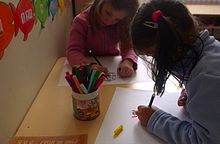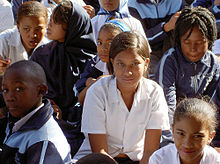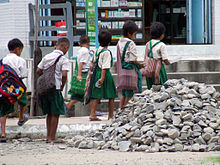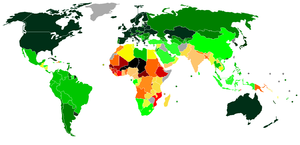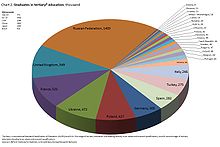- Education
-
"Educate" redirects here. For the journal published by the Institute of Education, see Educate~.For the stained-glass window at Yale University, see Education (Chittenden Memorial Window).
Education in its broadest, general sense is the means through which the aims and habits of a group of people lives on from one generation to the next.[1] Generally, it occurs through any experience that has a formative effect on the way one thinks, feels, or acts. In its narrow, technical sense, education is the formal process by which society deliberately transmits its accumulated knowledge, skills, customs and values from one generation to another, e.g., instruction in schools.
A right to education has been created and recognized by some jurisdictions: Since 1952, Article 2 of the first Protocol to the European Convention on Human Rights obliges all signatory parties to guarantee the right to education. At the global level, the United Nations' International Covenant on Economic, Social and Cultural Rights of 1966 guarantees this right under its Article 13.
Contents
Etymology
Etymologically, the word education is derived from the Latin ēducātiō (“a breeding, a bringing up, a rearing) from ēdūcō (“I educate, I train”) which is related to the homonym ēdūcō (“I lead forth, I take out; I raise up, I erect”) from ē- (“from, out of”) and dūcō (“I lead, I conduct”).[2]
Systems of schooling
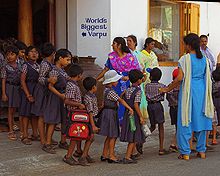 School children line, in Kerala, India
School children line, in Kerala, India
Systems of schooling involve institutionalized teaching and learning in relation to a curriculum, which itself is established according to a predetermined purpose of the schools in the system.
Purpose of schools
Main article: Education_theory#Normative_theories_of_educationExamples of the purpose of schools include:[3] develop reasoning about perennial questions, master the methods of scientific inquiry, cultivate the intellect, create change agents, develop spirituality, and model a democratic society.
Curriculum
In formal education, a curriculum is the set of courses, and their content, offered at a school or university. As an idea, curriculum stems from the Latin word for race course, referring to the course of deeds and experiences through which children grow to become mature adults. A curriculum is prescriptive, and is based on a more general syllabus which merely specifies what topics must be understood and to what level to achieve a particular grade or standard.
An academic discipline is a branch of knowledge which is formally taught, either at the university, or via some other such method. Each discipline usually has several sub-disciplines or branches, and distinguishing lines are often both arbitrary and ambiguous. Examples of broad areas of academic disciplines include the natural sciences, mathematics, computer science, social sciences, humanities and applied sciences.[4]
Preschools
Main article: Preschool educationPrimary schools
Main article: Primary education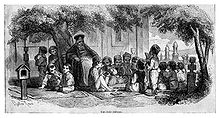 Primary school in open air. Teacher (priest) with class from the outskirts of Bucharest, around 1842.
Primary school in open air. Teacher (priest) with class from the outskirts of Bucharest, around 1842.
Primary (or elementary) education consists of the first 5–7 years of formal, structured education. In general, primary education consists of six or eight years of schooling starting at the age of five or six, although this varies between, and sometimes within, countries. Globally, around 89% of primary-age children are enrolled in primary education, and this proportion is rising.[5] Under the Education For All programs driven by UNESCO, most countries have committed to achieving universal enrollment in primary education by 2015, and in many countries, it is compulsory for children to receive primary education. The division between primary and secondary education is somewhat arbitrary, but it generally occurs at about eleven or twelve years of age. Some education systems have separate middle schools, with the transition to the final stage of secondary education taking place at around the age of fourteen. Schools that provide primary education, are mostly referred to as primary schools. Primary schools in these countries are often subdivided into infant schools and junior school.
Secondary schools
Main article: Secondary education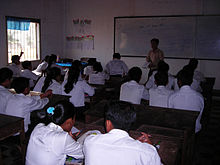 Students in a classroom at Samdach Euv High School, Cambodia
Students in a classroom at Samdach Euv High School, Cambodia
In most contemporary educational systems of the world, secondary education comprises the formal education that occurs during adolescence. It is characterized by transition from the typically compulsory, comprehensive primary education for minors, to the optional, selective tertiary, "post-secondary", or "higher" education (e.g., university, vocational school for adults. Depending on the system, schools for this period, or a part of it, may be called secondary or high schools, gymnasiums, lyceums, middle schools, colleges, or vocational schools. The exact meaning of any of these terms varies from one system to another. The exact boundary between primary and secondary education also varies from country to country and even within them, but is generally around the seventh to the tenth year of schooling. Secondary education occurs mainly during the teenage years. In the United States, Canada and Australia primary and secondary education together are sometimes referred to as K-12 education, and in New Zealand Year 1–13 is used. The purpose of secondary education can be to give common knowledge, to prepare for higher education or to train directly in a profession.
The emergence of secondary education in the United States did not happen until 1910, caused by the rise in big businesses and technological advances in factories (for instance, the emergence of electrification), that required skilled workers. In order to meet this new job demand, high schools were created and the curriculum focused on practical job skills that would better prepare students for white collar or skilled blue collar work. This proved to be beneficial for both the employer and the employee, because this improvement in human capital caused employees to become more efficient, which lowered costs for the employer, and skilled employees received a higher wage than employees with just primary educational attainment.
In Europe, the grammar school or academy existed from as early as the 16th century; public schools or fee-paying schools, or charitable educational foundations have an even longer history.
Indigenous education
Main article: Indigenous educationIndigenous education refers to the inclusion of indigenous knowledge, models, methods and content within formal and non-formal educational systems. Often in a post-colonial context, the growing recognition and use of indigenous education methods can be a response to the erosion and loss of indigenous knowledge and language through the processes of colonialism. Furthermore, it can enable indigenous communities to “reclaim and revalue their languages and cultures, and in so doing, improve the educational success of indigenous students.”[6]
Alternative education
Main article: Alternative educationAlternative education, also known as non-traditional education or educational alternative, is a broad term that may be used to refer to all forms of education outside of traditional education (for all age groups and levels of education). This may include not only forms of education designed for students with special needs (ranging from teenage pregnancy to intellectual disability), but also forms of education designed for a general audience and employing alternative educational philosophies and methods.
Alternatives of the latter type are often the result of education reform and are rooted in various philosophies that are commonly fundamentally different from those of traditional compulsory education. While some have strong political, scholarly, or philosophical orientations, others are more informal associations of teachers and students dissatisfied with certain aspects of traditional education. These alternatives, which include charter schools, alternative schools, independent schools, homeschooling and autodidacticism vary widely, but often emphasize the value of small class size, close relationships between students and teachers, and a sense of community.
Systems of higher education
Main article: Higher education The University of Cambridge is an institute of higher learning.
The University of Cambridge is an institute of higher learning.
Higher education, also called tertiary, third stage, or post secondary education, is the non-compulsory educational level that follows the completion of a school providing a secondary education, such as a high school or secondary school. Tertiary education is normally taken to include undergraduate and postgraduate education, as well as vocational education and training. Colleges and universities are the main institutions that provide tertiary education. Collectively, these are sometimes known as tertiary institutions. Tertiary education generally results in the receipt of certificates, diplomas, or academic degrees.
Higher education generally involves work towards a degree-level or foundation degree qualification. In most developed countries a high proportion of the population (up to 50%) now enter higher education at some time in their lives. Higher education is therefore very important to national economies, both as a significant industry in its own right, and as a source of trained and educated personnel for the rest of the economy.
University systems
University education includes teaching, research and social services activities, and it includes both the undergraduate level (sometimes referred to as tertiary education) and the graduate (or postgraduate) level (sometimes referred to as graduate school). Universities are generally composed of several colleges. In the United States, universities can be private and independent, like Yale University, they can be public and State governed, like the Pennsylvania State System of Higher Education, or they can be independent but State funded, like the University of Virginia.
Liberal arts colleges
A "liberal arts" institution can be defined as a "college or university curriculum aimed at imparting broad general knowledge and developing general intellectual capacities, in contrast to a professional, vocational, or technical curriculum."[7] Although what is known today as the liberal arts college began in Europe,[8] the term is commonly associated with the United States[citation needed]. Examples include Reed College, Carleton College, and Smith College.
Community colleges
Main article: community collegesAdult education
Main article: Adult educationAdult education has become common in many countries. It takes on many forms, ranging from formal class-based learning to self-directed learning and e-learning. A number of career specific courses such as veterinary assisting, medical billing and coding, real estate license, bookkeeping and many more are now available to students through the Internet.
Learning modalities
There has been work on learning styles over the last two decades. Dunn and Dunn[9] focused on identifying relevant stimuli that may influence learning and manipulating the school environment, at about the same time as Joseph Renzulli[10] recommended varying teaching strategies. Howard Gardner[11] identified individual talents or aptitudes in his Multiple Intelligences theories. Based on the works of Jung, the Myers-Briggs Type Indicator and Keirsey Temperament Sorter[12] focused on understanding how people's personality affects the way they interact personally, and how this affects the way individuals respond to each other within the learning environment. The work of David Kolb and Anthony Gregorc's Type Delineator[13] follows a similar but more simplified approach.
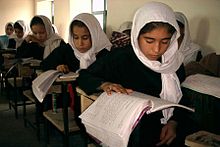 School girls in Afghanistan
School girls in Afghanistan
It is currently fashionable to divide education into different learning "modes". The learning modalities[14] are probably the most common:
- Visual: learning based on observation and seeing what is being learned.
- Auditory: learning based on listening to instructions/information.
- Kinesthetic: learning based on hands-on work and engaging in activities.
Although it is claimed that, depending on their preferred learning modality, different teaching techniques have different levels of effectiveness,[15] recent research has argued "there is no adequate evidence base to justify incorporating learning styles assessments into general educational practice."[16]
A consequence of this theory is that effective teaching should present a variety of teaching methods which cover all three learning modalities so that different students have equal opportunities to learn in a way that is effective for them.[17] Guy Claxton has questioned the extent that learning styles such as VAK are helpful, particularly as they can have a tendency to label children and therefore restrict learning.[18]
Instruction
 Teacher in a classroom in Madagascar
Teacher in a classroom in Madagascar
Instruction is the facilitation of another's learning. Instructors in primary and secondary institutions are often called teachers, and they direct the education of students and might draw on many subjects like reading, writing, mathematics, science and history. Instructors in post-secondary institutions might be called teachers, instructors, or professors, depending on the type of institution; and they primarily teach only their specific discipline. Studies from the United States suggest that the quality of teachers is the single most important factor affecting student performance, and that countries which score highly on international tests have multiple policies in place to ensure that the teachers they employ are as effective as possible.[19] With the passing of NCLB in the United States (No Child Left Behind), teachers must be highly qualified.
Technology
Main article: Educational technologyOne of the most substantial uses in education is the use of technology. Also technology is an increasingly influential factor in education. Computers and mobile phones are used in developed countries both to complement established education practices and develop new ways of learning such as online education (a type of distance education). This gives students the opportunity to choose what they are interested in learning. The proliferation of computers also means the increase of programming and blogging. Technology offers powerful learning tools that demand new skills and understandings of students, including Multimedia, and provides new ways to engage students, such as Virtual learning environments. One such tool are virtual manipulatives, which are an "interactive, Web-based visual representation of a dynamic object that presents opportunities for constructing mathematical knowledge" (Moyer, Bolyard, & Spikell, 2002). In short, virtual manipulatives are dynamic visual/pictorial replicas of physical mathematical manipulatives, which have long been used to demonstrate and teach various mathematical concepts. Virtual manipulatives can be easily accessed on the Internet as stand-alone applets, allowing for easy access and use in a variety of educational settings. Emerging research into the effectiveness of virtual manipulatives as a teaching tool have yielded promising results, suggesting comparable, and in many cases superior overall concept-teaching effectiveness compared to standard teaching methods.[citation needed] Technology is being used more not only in administrative duties in education but also in the instruction of students. The use of technologies such as PowerPoint and interactive whiteboard is capturing the attention of students in the classroom. Technology is also being used in the assessment of students. One example is the Audience Response System (ARS), which allows immediate feedback tests and classroom discussions.[20]
Information and communication technologies (ICTs) are a “diverse set of tools and resources used to communicate, create, disseminate, store, and manage information.”[21] These technologies include computers, the Internet, broadcasting technologies (radio and television), and telephony. There is increasing interest in how computers and the Internet can improve education at all levels, in both formal and non-formal settings.[22] Older ICT technologies, such as radio and television, have for over forty years been used for open and distance learning, although print remains the cheapest, most accessible and therefore most dominant delivery mechanism in both developed and developing countries.[23] In addition to classroom application and growth of e-learning opportunities for knowledge attainment, educators involved in student affairs programming have recognized the increasing importance of computer usage with data generation for and about students. Motivation and retention counselors, along with faculty and administrators, can impact the potential academic success of students by provision of technology based experiences in the University setting.[24]
The use of computers and the Internet is in its infancy in developing countries, if these are used at all, due to limited infrastructure and the attendant high costs of access. Usually, various technologies are used in combination rather than as the sole delivery mechanism. For example, the Kothmale Community Radio Internet uses both radio broadcasts and computer and Internet technologies to facilitate the sharing of information and provide educational opportunities in a rural community in Sri Lanka.[25] The Open University of the United Kingdom (UKOU), established in 1969 as the first educational institution in the world wholly dedicated to open and distance learning, still relies heavily on print-based materials supplemented by radio, television and, in recent years, online programming.[26] Similarly, the Indira Gandhi National Open University in India combines the use of print, recorded audio and video, broadcast radio and television, and audio conferencing technologies.[27]
The term "computer-assisted learning" (CAL) has been increasingly used to describe the use of technology in teaching. Classrooms of the 21st century contain interactive white boards, tablets, mp3 players, laptops, etc. Teachers are encouraged to embed these technological devices in the curriculum in order to enhance students learning and meet the needs of various types of learners.
Education theory
Main article: Education theoryEducation theory can refer to either a normative or a descriptive theory of education. In the first case, a theory means a postulation about what ought to be. It provides the "goals, norms, and standards for conducting the process of education."[28] In the second case, it means "an hypothesis or set of hypotheses that have been verified by observation and experiment."[29] A descriptive theory of education can be thought of as a conceptual scheme that ties together various "otherwise discrete particulars. . .For example, a cultural theory of education shows how the concept of culture can be used to organize and unify the variety of facts about how and what people learn."[30] Likewise, for example, there is the behaviorist theory of education that comes from educational psychology and the functionalist theory of education that comes from sociology of education.[31]
Economics and education
Main article: Economics of educationIt has been argued that high rates of education are essential for countries to be able to achieve high levels of economic growth.[32] Empirical analyses tend to support the theoretical prediction that poor countries should grow faster than rich countries because they can adopt cutting edge technologies already tried and tested by rich countries. However, technology transfer requires knowledgeable managers and engineers who are able to operate new machines or production practices borrowed from the leader in order to close the gap through imitation. Therefore, a country's ability to learn from the leader is a function of its stock of "human capital". Recent study of the determinants of aggregate economic growth have stressed the importance of fundamental economic institutions[33] and the role of cognitive skills.[34]
At the individual level, there is a large literature, generally related back to the work of Jacob Mincer,[35] on how earnings are related to the schooling and other human capital of the individual. This work has motivated a large number of studies, but is also controversial. The chief controversies revolve around how to interpret the impact of schooling.[36][37]
Economists Samuel Bowles and Herbert Gintis famously argued in 1976 that there was a fundamental conflict in American schooling between the egalitarian goal of democratic participation and the inequalities implied by the continued profitability of capitalist production on the other.[38]
History
Main article: History of education A depiction of the University of Bologna, Italy
A depiction of the University of Bologna, Italy
The history of education according to Dieter Lenzen, president of the Freie Universität Berlin 1994, "began either millions of years ago or at the end of 1770". Education as a science cannot be separated from the educational traditions that existed before. Adults trained the young of their society in the knowledge and skills they would need to master and eventually pass on. The evolution of culture, and human beings as a species depended on this practice of transmitting knowledge. In pre-literate societies this was achieved orally and through imitation. Story-telling continued from one generation to the next. Oral language developed into written symbols and letters. The depth and breadth of knowledge that could be preserved and passed soon increased exponentially. When cultures began to extend their knowledge beyond the basic skills of communicating, trading, gathering food, religious practices, etc., formal education, and schooling, eventually followed. Schooling in this sense was already in place in Egypt between 3000 and 500BC.The history of education is the history of man as since its the main occupation of man to pass knowledge, skills and attitude from one generation to the other so is education.
Nowadays some kind of education is compulsory to all people in most countries. Due to population growth and the proliferation of compulsory education, UNESCO has calculated that in the next 30 years more people will receive formal education than in all of human history thus far.[39]
Philosophy
Main article: Philosophy of education John Locke's work Some Thoughts Concerning Education was written in 1693 and still reflects traditional education priorities in the Western world.
John Locke's work Some Thoughts Concerning Education was written in 1693 and still reflects traditional education priorities in the Western world.
As an academic field, philosophy of education is a "the philosophical study of education and its problems...its central subject matter is education, and its methods are those of philosophy".[40] "The philosophy of education may be either the philosophy of the process of education or the philosophy of the discipline of education. That is, it may be part of the discipline in the sense of being concerned with the aims, forms, methods, or results of the process of educating or being educated; or it may be metadisciplinary in the sense of being concerned with the concepts, aims, and methods of the discipline."[41] As such, it is both part of the field of education and a field of applied philosophy, drawing from fields of metaphysics, epistemology, axiology and the philosophical approaches (speculative, prescriptive, and/or analytic) to address questions in and about pedagogy, education policy, and curriculum, as well as the process of learning, to name a few.[42] For example, it might study what constitutes upbringing and education, the values and norms revealed through upbringing and educational practices, the limits and legitimization of education as an academic discipline, and the relation between education theory and practice.
Psychology
Main article: Educational psychology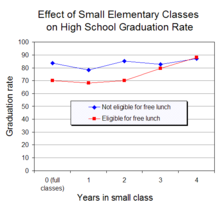 A class size experiment in the United States found that attending small classes for 3 or more years in the early grades increased high school graduation rates of students from low income families.[43]
A class size experiment in the United States found that attending small classes for 3 or more years in the early grades increased high school graduation rates of students from low income families.[43]
Educational psychology is the study of how humans learn in educational settings, the effectiveness of educational interventions, the psychology of teaching, and the social psychology of schools as organizations. Although the terms "educational psychology" and "school psychology" are often used interchangeably, researchers and theorists are likely to be identified as educational psychologists, whereas practitioners in schools or school-related settings are identified as school psychologists. Educational psychology is concerned with the processes of educational attainment in the general population and in sub-populations such as gifted children and those with specific disabilities.
Educational psychology can in part be understood through its relationship with other disciplines. It is informed primarily by psychology, bearing a relationship to that discipline analogous to the relationship between medicine and biology. Educational psychology in turn informs a wide range of specialities within educational studies, including instructional design, educational technology, curriculum development, organizational learning, special education and classroom management. Educational psychology both draws from and contributes to cognitive science and the learning sciences. In universities, departments of educational psychology are usually housed within faculties of education, possibly accounting for the lack of representation of educational psychology content in introductory psychology textbooks (Lucas, Blazek, & Raley, 2006).
Sociology
Main article: Sociology of education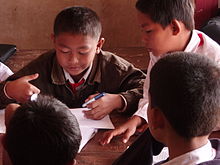 School children in Laos
School children in Laos
The sociology of education is the study of how social institutions and forces affect educational processes and outcomes, and vice versa. By many, education is understood to be a means of overcoming handicaps, achieving greater equality and acquiring wealth and status for all (Sargent 1994). Learners may be motivated by aspirations for progress and betterment. Education is perceived as a place where children can develop according to their unique needs and potentialities.[44] The purpose of education can be to develop every individual to their full potential. The understanding of the goals and means of educational socialization processes differs according to the sociological paradigm used.
Education in the developing world
World map indicating Education Index (according to 2007/2008 Human Development Report)
Universal Primary Education is one of the eight Millennium Development Goals and great improvements have been achieved in the past decade, yet a great deal remains to be done.[45] Researchers at the Overseas Development Institute indicate the main obstacles to greater funding from donors include: donor priorities, aid architecture, and the lack of evidence and advocacy.[45] Additionally, Transparency International has identified corruption in the education sector as a major stumbling block to achieving Universal Primary Education in Africa.[46] Furthermore, demand in the developing world for improved educational access is not as high as one would expect as governments avoid the recurrent costs involved and there is economic pressure on those parents who prefer their children making money in the short term over any long-term benefits of education. Recent studies on child labor and poverty have suggested that when poor families reach a certain economic threshold where families are able to provide for their basic needs, parents return their children to school. This has been found to be true, once the threshold has been breached, even if the potential economic value of the children's work has increased since their return to school.
But without capacity, there is no development. A study conducted by the UNESCO International Institute for Educational Planning indicates that stronger capacities in educational planning and management may have an important spill-over effect on the system as a whole.[47] Sustainable capacity development requires complex interventions at the institutional, organizational and individual levels that could be based on some foundational principles:
- national leadership and ownership should be the touchstone of any intervention;
- strategies must be context relevant and context specific;
- they should embrace an integrated set of complementary interventions, though implementation may need to proceed in steps;
- partners should commit to a long-term investment in capacity development, while working towards some short-term achievements;
- outside intervention should be conditional on an impact assessment of national capacities at various levels.
[when?]
A lack of good universities, and a low acceptance rate for good universities, is evident in countries with a high population density. In some countries, there are uniform, over structured, inflexible centralized programs from a central agency that regulates all aspects of education.
- Due to globalization, increased pressure on students in curricular activities
- Removal of a certain percentage of students for improvisation of academics (usually practised in schools, after 10th grade)
India is now developing technologies that will skip land based telephone and internet lines. Instead, India launched EDUSAT, an education satellite that can reach more of the country at a greatly reduced cost. There is also an initiative started by the OLPC foundation, a group out of MIT Media Lab and supported by several major corporations to develop a $100 laptop to deliver educational software. The laptops are widely available as of 2008. The laptops are sold at cost or given away based on donations. These will enable developing countries to give their children a digital education, and help close the digital divide across the world.
In Africa, the New Partnership for Africa's Development (NEPAD) has launched an "e-school program" to provide all 600,000 primary and high schools with computer equipment, learning materials and internet access within 10 years. Private groups, like The Church of Jesus Christ of Latter-day Saints, are working to give more individuals opportunities to receive education in developing countries through such programs as the Perpetual Education Fund. An International Development Agency project called nabuur.com, started with the support of former American President Bill Clinton, uses the Internet to allow co-operation by individuals on issues of social development.
In Brazil, education is improving (slowly). With the Education Minister Fernando Haddad, certain situations have changed, as the implementation of the New Enem, PROUNI, Fies, ENADE, SISU among other government programs important to the growth of education.[48]
Internationalization
Education is becoming increasingly international. Not only are the materials becoming more influenced by the rich international environment, but exchanges among students at all levels are also playing an increasingly important role. In Europe, for example, the Socrates-Erasmus Program[49] stimulates exchanges across European universities. Also, the Soros Foundation [50] provides many opportunities for students from central Asia and eastern Europe. Programs such as the International Baccalaureate have contributed to the internationalisation of education. Some scholars argue that, regardless of whether one system is considered better or worse than another, experiencing a different way of education can often be considered to be the most important, enriching element of an international learning experience.[51]
See also
- Glossary of education-related terms
- Index of education articles
- Outline of education
References
- ^ Dewey, John (1916/1944). Democracy and Education. The Free Press. pp. 1-4. ISBN 0-684-83631-9.
- ^ educate. Etymonline.com. Retrieved on 2011-10-21.
- ^ Webb, DL, A Metha, and KF Jordan (2010). Foundations of American Education, 6th Ed. Upper Saddle River, NJ: Merill, pp. 55–91
- ^ "Examples of subjects". Curriculumonline.gov.uk. http://www.curriculumonline.gov.uk/Default.htm. Retrieved 2009-04-20.
- ^ UNESCO, Education For All Monitoring Report 2008, Net Enrollment Rate in primary education
- ^ May, S. and Aikman, S. (2003). "Indigenous Education: Addressing Current Issues and Developments". Comparative Education 39 (2): 139–145. doi:10.1080/03050060302549. JSTOR 3099875.
- ^ "Liberal Arts: Encyclopedia Britannica Concise". Encyclopedia Britannica. http://concise.britannica.com/ebc/article-9370154/liberal-arts.
- ^ Harriman, Philip (1935). "Antecedents of the Liberal Arts College". The Journal of Higher Education (The Journal of Higher Education) 6 (2): 63–71. JSTOR 1975506.
- ^ "Dunn and Dunn". Learningstyles.net. http://www.learningstyles.net/. Retrieved 2009-04-20.
- ^ "Biographer of Renzulli". Indiana.edu. http://www.indiana.edu/~intell/renzulli.shtml. Retrieved 2009-04-20.
- ^ Thomas Armstrong's website detailing Multiple Intelligences
- ^ "Keirsey web-site". Keirsey.com. http://www.keirsey.com/. Retrieved 2009-04-20.
- ^ "Type Delineator description". Algonquincollege.com. http://www.algonquincollege.com/edtech/gened/styles.html. Retrieved 2009-04-20.
- ^ Swassing, R. H., Barbe, W. B., & Milone, M. N. (1979). The Swassing-Barbe Modality Index: Zaner-Bloser Modality Kit. Columbus, OH: Zaner-Bloser.
- ^ Barbe, W. B., & Swassing, R. H., with M. N. Milone. (1979). Teaching through modality strengths: Concepts and practices. Columbus, OH: Zaner-Bloser,
- ^ Pashler, Harold; McDonald, Mark; Rohrer, Doug; Bjork, Robert (2009). "Learning Styles: Concepts and Evidence". Psychological Science in the Public Interest 9 (3): 105–119. doi:10.1111/j.1539-6053.2009.01038.x. http://www.psychologicalscience.org/journals/pspi/PSPI_9_3.pdf.
- ^ "Learning modality description from the Learning Curve website". Library.thinkquest.org. http://library.thinkquest.org/C005704/content_hwl_learningmodalities.php3. Retrieved 2010-06-19.
- ^ "Guy Claxton speaking on What's The Point of School?". dystalk.com. http://www.dystalk.com/talks/49-whats-the-point-of-school. Retrieved 2009-04-23.
- ^ How the world's best-performing school systems come out on top. mckinsey.com. September 2007
- ^ Tremblay, Eric. "(2010) Educating the Mobile Generation – using personal cell phones as audience response systems in post-secondary science teaching. Journal of Computers in Mathematics and Science Teaching, 29(2), 217–227. Chesapeake, VA: AACE.". http://editlib.org/p/32314. Retrieved 2010-11-05.
- ^ Blurton, Craig. "New Directions of ICT-Use in Education" (PDF). http://www.unesco.org/education/educprog/lwf/dl/edict.pdf. Retrieved 2007-02-06.
- ^ ICT in Education
- ^ Potashnik, M. and Capper, J.. "Distance Education:Growth and Diversity" (PDF). http://www.worldbank.org/fandd/english/pdfs/0398/0110398.pdf. Retrieved 2007-02-06.
- ^ Whyte, Cassandra Bolyard (1989) Student Affairs-The Future.Journal of College Student Development, v30 n1 p86-89.
- ^ Taghioff, Daniel. "Seeds of Consensus—The Potential Role for Information and Communication Technologies in Development.". Archived from the original on 2003-10-12. http://web.archive.org/web/20031012140402/http://www.btinternet.com/~daniel.taghioff/index.html. Retrieved 2003-10-12.
- ^ Open University of the United Kingdom Official website
- ^ Indira Gandhi National Open University Official website
- ^ Dolhenty, Jonathan. "Philosophy of Education and Wittgenstein's Concept of Language-Games". The Radical Academy. http://www.radicalacademy.com/phillangames1.htm. Retrieved 19 November 2010.
- ^ Kneller, George (1964). Introduction to the Philosophy of Education. New York, NY: John Wiley & Sons. p. 93.
- ^ Philip H. Phenix (1963). "Educational Theory and Inspiration". Educational Theory 13 (1): 1–64. doi:10.1111/j.1741-5446.1963.tb00101.x.
- ^ Webb, DL, A Metha, and KF Jordan (2010). Foundations of American Education, 6th Ed. Upper Saddle River, NJ: Merill, pp. 77–80, 192–193.
- ^ Eric A. Hanushek (2005). Economic outcomes and school quality. International Institute for Educational Planning. ISBN 978-92-803-1279-9. http://books.google.com/books?id=na7rAAAACAAJ. Retrieved 21 October 2011.
- ^ Daron Acemoglu, Simon Johnson, and James A. Robinson (2001). "The Colonial Origins of Comparative Development: An Empirical Investigation". American Economic Review 91 (5): 1369–1401. doi:10.2139/ssrn.244582. JSTOR 2677930. http://economics.mit.edu/files/4123.
- ^ Eric A. Hanushek and Ludger Woessmann (2008). "The role of cognitive skills in economic development". Journal of Economic Literature 46 (3): 607–608. doi:10.1257/jel.46.3.607. http://edpro.stanford.edu/Hanushek/admin/pages/files/uploads/Hanushek_Woessmann_2008_JEL_46.pdf.
- ^ Jacob Mincer (1970). "The distribution of labor incomes: a survey with special reference to the human capital approach". Journal of Economic Literature 8 (1): 1–26. JSTOR 2720384.
- ^ David Card, "Causal effect of education on earnings," in Handbook of labor economics, Orley Ashenfelter and David Card (Eds). Amsterdam: North-Holland, 1999: pp. 1801–1863
- ^ James J. Heckman, Lance J. Lochner, and Petra E. Todd., "Earnings functions, rates of return and treatment effects: The Mincer equation and beyond," in Handbook of the Economics of Education, Eric A. Hanushek and Finis Welch (Eds). Amsterdam: North Holland, 2006: pp. 307–458.
- ^ Samuel Bowles; Herbert Gintis (18 October 2011). Schooling In Capitalist America: Educational Reform and the Contradictions of Economic Life. Haymarket Books. ISBN 978-1-60846-131-8. http://books.google.com/books?id=LcpLPKOL6XYC. Retrieved 21 October 2011.
- ^ Robinson, K.: Schools Kill Creativity. TED Talks, 2006, Monterrey, CA, USA.
- ^ Noddings, Nel (1995). Philosophy of Education. Boulder, CO: Westview Press. p. 1. ISBN 0-8133-8429-X.
- ^ Frankena, William K.; Raybeck, Nathan; Burbules, Nicholas (2002). "Philosophy of Education". In Guthrie, James W.. Encyclopedia of Education, 2nd edition. New York, NY: Macmillan Reference. ISBN 0-02-865594-X.
- ^ Noddings 1995, pp. 1–6
- ^ Finn, J. D., Gerber, S. B., Boyd-Zaharias, J. (2005). "Small classes in the early grades, academic achievement, and graduating from high school". Journal of Educational Psychology 97 (2): 214–233. doi:10.1037/0022-0663.97.2.214. http://www.apa.org/pubs/journals/releases/edu-972214.pdf.
- ^ Schofield, K. (1999). The Purposes of Education, Queensland State Education
- ^ a b Liesbet Steer and Geraldine Baudienville 2010. What drives donor financing of basic education? London: Overseas Development Institute.
- ^ news room/latest news/press_releases/2010/2010_02_23_AEW_launch_en. Transparency.org (2010-02-23). Retrieved on 2011-10-21.
- ^ de Grauwe, A. 2009. Without capacity, there is no development. Paris: UNESCO-IIPE [1].
- ^ Educação e Universidades autorizadas no MEC – Education / university has been improving in Brazil
- ^ "Socrates-Erasmus Program". Erasmus.ac.uk. http://www.erasmus.ac.uk. Retrieved 2010-06-19.
- ^ "Soros Foundation". Soros.org. http://www.soros.org/. Retrieved 2010-06-19.
- ^ Dubois, H. F. W., Padovano, G., & Stew, G. (2006). "Improving international nurse training: an American–Italian case study". International Nursing Review 53 (2): 110–116. doi:10.1111/j.1466-7657.2006.00464.x. PMID 16650029.
External links
- Education at the Open Directory Project
- Educational Resources from UCB Libraries GovPubs
- UNESCO Institute for Statistics: International comparable statistics on education systems
- OECD education statistics
- Planipolis: a portal on education plans and policies
- IIEP Publications on Education Systems
Topics in education Higher education by country Countries - Afghanistan
- Albania
- Algeria
- Angola
- Argentina
- Armenia
- Australia
- Austria
- Azerbaijan
- Bahamas
- Bahrain
- Bangladesh
- Barbados
- Belarus
- Belgium
- Belize
- Benin
- Bhutan
- Bolivia
- Bosnia and Herzegovina
- Botswana
- Brazil
- Bulgaria
- Burkina Faso
- Burma
- Burundi
- Cambodia
- Cameroon
- Canada
- Cape Verde
- Central African Republic
- Chad
- Chile
- China
- Colombia
- Comoros
- Costa Rica
- Côte d'Ivoire
- Croatia
- Cuba
- Cyprus
- Czech Republic
- Democratic Republic of the Congo
- Denmark
- Djibouti
- Dominica
- Dominican Republic
- Ecuador
- Egypt
- El Salvador
- Equatorial Guinea
- Eritrea
- Estonia
- Ethiopia
- Federated States of Micronesia
- Fiji
- Finland
- France
- Gabon
- Gambia
- Georgia
- Germany
- Ghana
- Greece
- Guatemala
- Guinea
- Guinea-Bissau
- Guyana
- Haiti
- Honduras
- Hong Kong
- Hungary
- Iceland
- India
- Indonesia
- Iran
- Iraq
- Ireland
- Israel
- Italy
- Jamaica
- Japan
- Jordan
- Kazakhstan
- Kenya
- Kiribati
- Kuwait
- Kyrgyzstan
- Laos
- Latvia
- Lebanon
- Lesotho
- Liberia
- Libya
- Liechtenstein
- Lithuania
- Luxembourg
- Macau
- Republic of Macedonia
- Madagascar
- Malawi
- Malaysia
- Maldives
- Mali
- Malta
- Mauritania
- Mauritius
- Mexico
- Moldova
- Mongolia
- Montenegro
- Morocco
- Mozambique
- Namibia
- Nepal
- Netherlands
- New Zealand
- Nicaragua
- Niger
- Nigeria
- North Korea
- Norway
- Oman
- Pakistan
- Panama
- Papua New Guinea
- Paraguay
- Peru
- Philippines
- Poland
- Portugal
- Qatar
- Republic of the Congo
- Romania
- Russia
- Rwanda
- Saint Lucia
- Saint Vincent and the Grenadines
- Samoa
- São Tomé and Príncipe
- Saudi Arabia
- Senegal
- Serbia
- Seychelles
- Sierra Leone
- Singapore
- Slovakia
- Slovenia
- Solomon Islands
- South Africa
- South Korea
- South Sudan
- Spain
- Sri Lanka
- Sudan
- Suriname
- Swaziland
- Sweden
- Switzerland
- Syria
- Taiwan
- Tajikistan
- Tanzania
- Thailand
- Timor-Leste
- Togo
- Tonga
- Trinidad and Tobago
- Tunisia
- Turkey
- Turkmenistan
- Uganda
- Ukraine
- United Arab Emirates
- United Kingdom
- United States
- Uruguay
- Uzbekistan
- Vanuatu
- Venezuela
- Vietnam
- Yemen
- Zambia
- Zimbabwe
Wikimedia Foundation. 2010.
Synonyms:
Look at other dictionaries:
ÉDUCATION — UNE PRISE DE VUE sur l’éducation ne peut se révéler que vertigineuse, tant sont aujourd’hui accusées l’ampleur, la diversité, voire l’incohérence du champ recouvert et des perspectives qu’on y trace. Et il sera vain de penser conjurer la… … Encyclopédie Universelle
Education — Éducation Ces moyens mnémotechniques mis à disposition des enfants visitant le Field Museum de Chicago permettent d apprendre les pays formant l Asie et leurs contours géographiques … Wikipédia en Français
Education — • In the broadest sense, education includes all those experiences by which intelligence is developed, knowledge acquired, and character formed. In a narrower sense, it is the work done by certain agencies and institutions, the home and the school … Catholic encyclopedia
Education — Education has been a priority for Israel since independence, although there was already substantial growth of Jewish education under the British mandate. During Israel s earliest years, the educational system was characterized by tremendous… … Historical Dictionary of Israel
Education.au — Education.au, established in 1996, is a not for profit ministerially owned national company located in Adelaide, South Australia. It is governed through a Board by nominees from the Australian Government, higher education, school education, and… … Wikipedia
education — ed‧u‧ca‧tion [ˌedjʊˈkeɪʆn ǁ ˌedʒə ] noun [uncountable] the process of learning, for example at schools and universities, and the process by which your mind develops through doing this: • The most important element of business education is… … Financial and business terms
Education — Ed u*ca tion (?; 135), n. [L. educatio; cf. F. [ e]ducation.] The act or process of educating; the result of educating, as determined by the knowledge skill, or discipline of character, acquired; also, the act or process of training by a… … The Collaborative International Dictionary of English
éducation — ÉDUCATION. s. f. Le soin qu on prend de l instruction des enfans, soit en ce qui regarde les exercices de l esprit, soit en ce qui regarde les exercices du corps, et principalement en ce qui regarde les moeurs. Bonne éducation. Mauvaise éducation … Dictionnaire de l'Académie Française 1798
education — EDUCATION. s. f. Le soin qu on prend de l instruction des enfants, soit en ce qui regarde les exercices de l esprit, soit en ce qui regarde les exercices du corps. Bonne education. mauvaise education. l education des enfants. prendre soin de l… … Dictionnaire de l'Académie française
Education — allergy bullying bullycide bullyproofing car schooling digital native dipstick dormcest dropout fa … New words
education — 1530s, childrearing, also the training of animals, from M.Fr. education (14c.) and directly L. educationem (nom. educatio), from pp. stem of educare (see EDUCATE (Cf. educate)). Originally of education in social codes and manners; meaning… … Etymology dictionary

